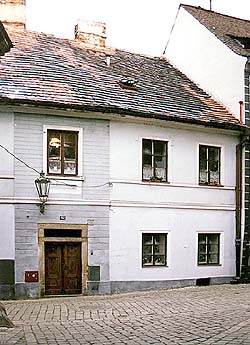Dlouhá No. 92
Description of the Building:
A one-storey extensive house with a Classical front and a linear
saddle roof. The back part of the house is covered with an aisle
roof.
Architectural and Historical Development:
The building is of medieval origin. A ground floor right hand side
section with two fields of ridged vaults and cellar vaults have
been preserved from the time of the Rennaissance reconstruction. In
the Baroque period a reconstruction of the facade was probably
carried out - a granite ribbon type portal is dated 1668. During
Classicism a reconstruction of the facade, a corridor behind the
staircase, and the upper hall was done. In that time the back
ground floor sections were adjusted for economic use. In the 1970s
division walls on the ground and first floors were set. In 1993 the
ground floor sections were again modified for commercial use.
Significant Architectural Features:
- Rennaissance ridged vaults in the ground floor section
- cellars with Rennaissance stone vaults and cobble paving
- a joist ceiling with a single decking in the back of the ground floor section
- several secondarily embedded doors with ornamental hinges
- partial town wall sections in the rear elevation
History of the House Residents:
The first known owner of the house, at the beginning of the 16th
century, was a maltster Jan, called Šenhansl, who died in 1517.
After him a butcher Zikmund settled there. He liked using the
surname Šenhansl, and was a member of the town council in the
1520s. In 1548 Zikmund´s wife Kateřina died and three years later
Zikmund handed the house down to his son-in-law Michal, who had
married his daughter Maruše. Michal died in 1552 and then several
owners changed in the house. In 1567 it was Řehoř Scheringharl, in
1571 Pavel Reichenpacher, in 1574 Adam Perger and at the end of the
1570s Ondřej Kvasnička, who sold it to Jiří Kunsteter ( Gunstetter
) in 1579. But he did not stay there long and sold a smaller part
of his house to a furrier Toman ( Tomáš ) Höslinger in 1581. Tomáš
rebuilt it into the present house No. 91, and changed an essential
part with a maltster Jiří Landsknecht. Landsknecht got rid of it
soon and in 1584 Ondřej Hrachovec moved in. He sold the house in
the same year to a cook Jan Kotman, who was better known as Kocián.
The cook Kocián died in 1607 and left a widow Regina and a daughter
Alena. Until 1654 the house then belonged to Matyáš Prošek. From
1654 a shoemaker Jan Kocián owned it and in the years 1690 - 1694 a
tawer Jeroným Lansser, who provided service even for the Krumlov
castle. Then an organ-builder Josef Egger moved in the house and
was followed by a tawer Martin Osimus in 1698. We do not have any
more detailed information about the following owners in the 18th
and the 19th centuries.
Present Use:
Domestika - ceramics, home furnishings, Original Czech mode


